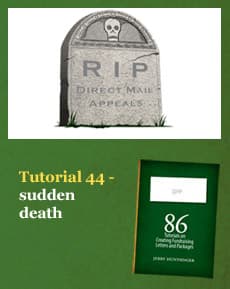Tutorial 44: sudden death
When a reader picks up your non-personalised letter, you have about five seconds before your letter suffers sudden death: one … two … three … four … five – and that’s it.
- Written by
- Jerry Huntsinger
- Added
- January 16, 2019

Your reader opens the envelope, scans the letter and all the while her mind is full.
One: that crazy dog chewed the newspaper again!
Two: I’m looking forward to seeing the grandchildren tomorrow.
Three: where is my bank statement?
Four: tonight I’ll wear my new dress.
Time’s up! Her hands move to another letter.
But if you capture her interest and get her mind off the daily routine she will welcome a pleasant interlude – and your appeal has a chance.
If your letter comes with a real ‘live’ stamp, give yourself 10 seconds. A stamp automatically flags a letter as being important. If the letter is personalised you may stretch your luck to 15 seconds. People are almost always momentarily stopped by their own name.
In fact, most donors really would like to get interested.
But most fundraising letters die a quiet, merciful death in the opening words, fading away, expiring without fanfare, buried in boredom. Maybe the term ‘sudden death’ is wrong. Maybe the letter was never alive in the first place.
The headline
A headline in a letter? If you are writing a generic (i.e. non-personalised) letter, the answer is yes. Many years ago, the writers of sales letters proved that if the letter was not personalised a headline out-pulled all other techniques.
This has also been proved true for fundraising letters.
Here’s why: in a personal letter the individual is accustomed to seeing his name and address at the top of the letter. You can’t provide this in a generic letter, so you do the next best thing: the reader expects to see her name and address, but instead reads an exciting headline.
Unless your headline stops the reader your letter will not be read.
Why should a reader get turned on, tuned in, or even tempted to read your letter? Unless the headline leaps out and grabs her, your letter flutters out of her hand.
A generic letter is much like a magazine advertisement. You have to stop the reader – before the page is turned.
Along with stopping the reader, the headline also sets the tone, announces the theme, and sets the pace for the entire letter.
Headlines are difficult to classify, but let’s isolate eight different types:
1. The non-headline: this weak headline is easy to spot.
Millions face starvation unless help is available
‘Millions face starvation’ is common knowledge, tragic as it may be. Obviously they will starve unless help is available. The sentence is a statement of fact.
The only reason you are using a headline is because you cannot afford to personalise the letter. So don’t ensure total failure by writing a non-headline.
2. Good news.
Unfortunately, this rarely works. Donors usually will not get turned on by good news. Donors associate charity with bad news.
Once in awhile you can write a good news headline to your house file – but only if the news is that you have discovered a cure for a problem and you need money to make it all come true.
Cure discovered for leprosy patients
This is vital, important news. Every person who contributes to leprosy work should be thrilled that a breakthrough has been achieved. But a person can’t write a cheque while clapping her hands.
Good news is difficult to translate into money.
3. Disaster: now we are close to success.
Disaster almost always out pulls any other type of headline. Why? Because people are turned on by bad news. Check the headlines in your newspaper. Count the bad news reports on the evening news.
You cannot make every letter and every headline a disaster. But don’t fight human nature. Disaster gets attention.
4. Emergency: this is almost as strong as a disaster. And often an emergency occurs after a disaster strikes.
Every fundraising letter must have a certain element of emergency, or why should you be asking people to give money?
5. Crisis: the word is magic. Try it.
This is a step-down from both the disaster and the emergency. A crisis can come on many levels, large or small.
6. Here’s how.
This type of headline is a bit commercial at times, but if you don’t have a disaster, emergency, a crisis, or can’t offer a free gift, the ‘here’s how; approach is usually successful.
Here’s how you can save a widow and her three children
7. The narrative headline.
A narration is simply telling a story. A narrative headline jumps right into the action of the story.
Hunger is all she has ever known
8. The off-beat headline.
Here, you must be careful. I remember a letter I did for a missionary organisation. All I had to go on was a picture of a tractor. So I thought it would be fun to personify the tractor, endow it with human characteristics. The headline:
Here’s how you can send your love to a tractor!
The letter worked. I was lucky.
Trigger words in the headline
Certain trigger words are vital in a headline. Is this because copywriters prefer certain words? No, the answer is simple: certain words have been tested and proved to excite interest in a headline.
For example:
Announcing
New
Emergency
Crisis
Disaster
At last
Beginning
Free
How to
Here’s how
Why
Make sure your headline:
1. Excites and grabs the reader.
2. Sets the pace for the letter.
You should read John Caples’ on headlines in his excellent book, Tested Advertising Methods (Prentice Hall Classics, USA, 1998). He wrote the classic ad, ‘They Laughed When I Sat Down at the Piano’.
Lead sentences
The lead sentence should be tied directly into the headline. Don’t introduce a new idea. Often, the best lead sentence is practically a sub-head, moving the main headline forward.
For example, the headline:
Here’s how you can send your love to a tractor!
Dear friend:
A tractor? Yes. A Massey Ferguson tractor – a machine that’s helping 150 small farmers escape the terror of starvation.
Or the headline:
Cure Discovered For Leprosy Patients
Dear friend:
At last! Thanks to Dr. Randall’s brilliant research, the fight against leprosy can now be won!
Or the headline:
Here’s how you can save a widow and her three children
Dear friend:
When I first saw this poor woman, desperately searching a garbage dump for scraps of food, I didn’t know she had three children in a shack, and all of them slowly starving to death.
Your headline cannot just hang in space at the top of the letter. The lead sentence must provide a definite connection. In fact, this is at the heart of most successful form letters – a strong headline, a captivating lead sentence and, then, a definite movement from paragraph to paragraph.
© SOFII Foundation 2010-2014.

















